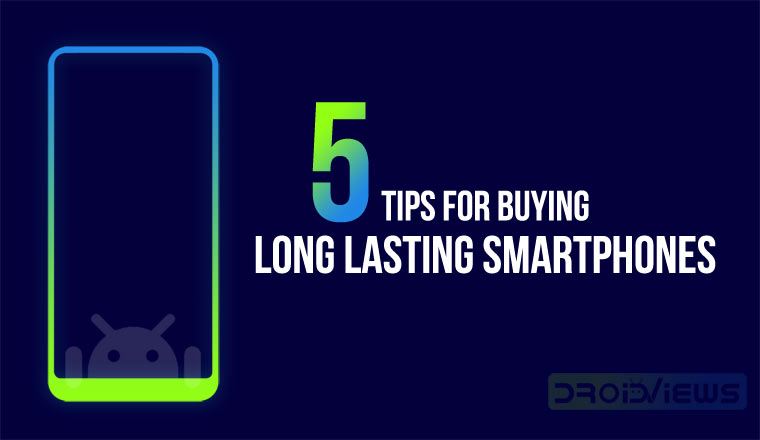
Some people buy new smartphones as a luxury because they want to own the latest phone in the market. There are others who like to keep using a phone as long as it is usable. Here are 5 tips for buying Android smartphones that will last long enough. If you going to buy a new smartphone, keep your wallet in the pocket and the following 5 tips in your mind.
Since the first smartphone appeared in the mid-90s, a huge technology market has emerged over the production and distribution of smartphone devices. Nowadays, smartphones running Android enjoy the highest market share. A typical Android device is designed to last up to a couple of years of usage.
The pace of hardware advancements and the increasing performance needs of software do not leave space for anything more. The pre-installed Android version is expected to get an unsupported status in two years. Except if the manufacturer decides to upgrade the Operating System through an OTA or Over-The-Air update.
For a typical Android user that does not afford to spend a fortune on smartphone purchases, but also seeks safety and performance, choosing an Android device to buy might be an overly difficult task. If you belong to this kind of users, this guide is written in an effort to assist in your decision. Keep reading below for a list of five small but significant tips on buying an Android device with guaranteed longevity.
5 Tips for Buying Android Smartphones
1. Go for a Mid-range Device
It is always better to invest more money in getting something of better quality than choosing something cheap that will soon lose its use value. A budget device is almost always convicted to fail in keeping up with software advancements. Most manufacturers never produce even a single update for their budget offerings. These devices remain prone to security vulnerabilities and usually contain software bugs that nobody cares to resolve. Even on the custom development field, not many developers care to support budget devices.
Moreover, budget devices ship with low processing power hardware, which is usually one generation back in terms of technology standards. A budget device will typically be incapable of utilizing modern software and technologies one year after its release.
Buying a flagship device is also not always the best way to go. Unless you can buy a flagship from a manufacturer that guarantees to provide upgrades to at least the next two Android versions, it is better to go for something mid-range with half the money instead. Buying a second-hand flagship from two or three years ago does not seem to be a wise idea either.
The hardware of flagships tends to fall behind standards as fast as mid-range devices. To get an idea, consider H.265 video playback. Many content providers already adopted this coding and highest quality content is most times only available on H.265. Flagships produced two years ago do not support H.265 decoding.
2. Buy a Device that Enjoys a Large Fan Base and Custom Development
As we all know, manufacturers usually provide software upgrades for their devices for a maximum of three years. However, if the device does not produce high sale numbers, it is possible that support might end prematurely. After all, everything is guided by profit. If sales get stuck, there is no reason for supporting a device further. Precious human resources can work for next-generation developments instead.
Furthermore, if you want your device to stay relevant in terms of software for more than three years, you should choose a device that has custom ROMs officially ported to it. A custom ROM will usually give an Android device software updates for up to five years. Custom development targets are usually mid and high-range devices from manufacturers that allow unlocking boot-loaders and release their kernel source code. The bigger the community surrounding an Android device’s custom development, the better the quality of the custom product and the longer the software support.
3. Get a Smartphone which Ships with the Latest Android Version
In recent years, we evidenced smartphone manufacturers producing devices running an Android version that is one or two versions behind the latest. There are many reasons for this. Firstly, such move minimizes development effort. Just porting existing source code from earlier devices is far less time consuming than starting from scratch.
Secondly, choosing an earlier version of Android guarantees less effort to keep up with Google’s standards. Google tends to increase its Android Compatibility requirements for manufacturers with each new version of its Operating System. Despite the reason a smartphone ships with an old Android version, it is almost certain that it will not get the needed attention from the community or the manufacturer during its life-cycle. A manufacturer that tries to cut development time and expenses is simply not trustworthy for providing future support for its products.
Must read: Malware on Android – Everything You Need to Know
4. Choose your Hardware Wisely
This might be the most difficult task in the process of choosing your next smartphone. To make sure you get a device that will last for long, you should buy something with up to date hardware characteristics. Hardware parts that tend to change drastically from year to year are the CPU, the GPU, the video encoder/decoder and the modem. Most mid-range offerings from SoC manufacturers are designed so they can handle technology standards that will be adopted in the next couple of years. So, your best candidates are devices that ship with a chip-set up to one year old.
5. Expensive products are not always the best
Unless you need special characteristics like an AMOLED display or an exceptional camera sensor, long-standing manufacturers with expensive products are not your only choices. Smaller sized companies appeared in recent years, providing decent quality products with high performance at low prices. These manufacturers applied a special strategy that has proven successful.
Firstly, most of them operate in Asia. This allows reducing shipping and production costs since almost all electronic equipment in smartphones is produced in Asia nowadays. They also reduce their operational costs by applying practices like selling only through Websites. There is a catch though: Not all Asia-based manufacturers provide competitive products. Many of these companies have failed to deliver and ended up in bankruptcy. A simple Google search will reveal the highest-ranking Asia-based manufacturers.
These are our tips for choosing an Android device that will last in time. We avoided mentioning manufacturer names in the article to avoid influencing user opinions. After all, the manufacturer of a smartphone is not everything that matters today. Did you find this guide helpful? Let us know in the comments section below.



Join The Discussion: